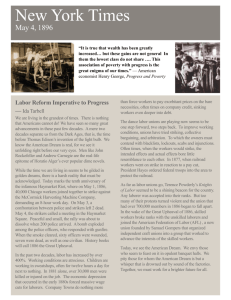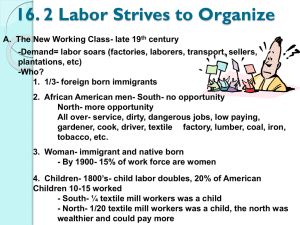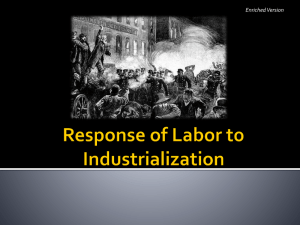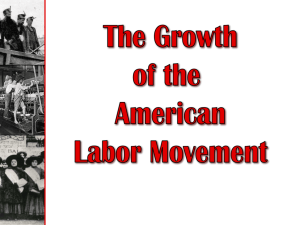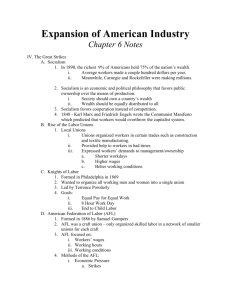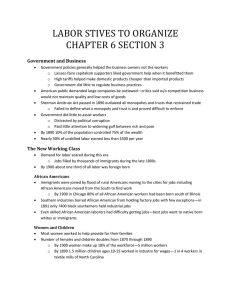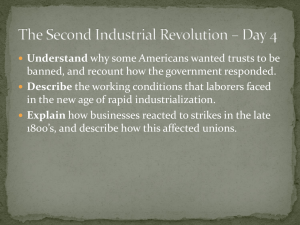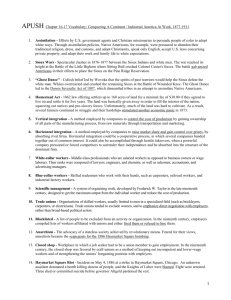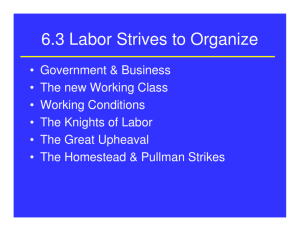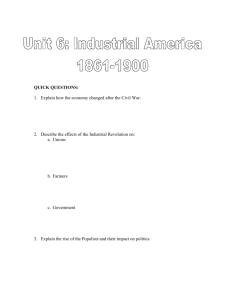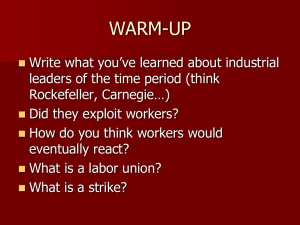Labor Movement - Moore Public Schools
advertisement
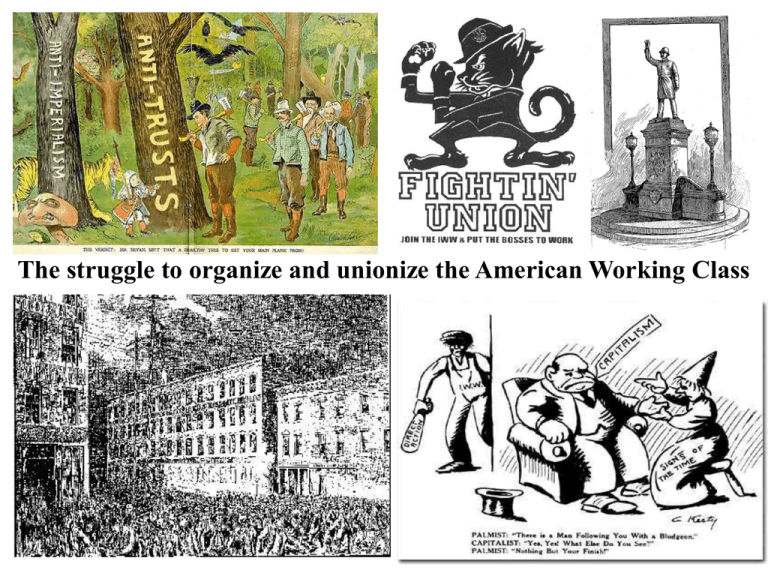
The struggle to organize and unionize the American Working Class Why did some Americans want trusts to be banned and how did the government respond? The United States government’s policies concerning business practices most often benefited the industrialists and not the workers. Although the industrialists claimed that they wanted no government interference in the Economy (laissez-faire) they welcomed the interference when it helped them. The government did little to regulate business even thought the general public complained. Congress did pass the Sherman Antitrust Act of 1890, but this law was poorly written and failed to define what a monopoly was. It couldn’t be enforced effectively. The government offered little support to the common worker. Because they were often distracted by government corruption, politicians paid little attention to the widening gulf between the rich and the poor. By1890, 75% of the wealth of the nation was held by only 10% of the people. Fifty percent of the population making less than 500 dollars a year. They were a very cheap source of labor. What types of working conditions did laborers face in this new age of rapid industrialization? The American work forced was made up of immigrants (whom we will discuss later), rural Americans looking for a better life, African-Americans from the south, women and children. By 1900, one-third of the workforce was made up of immigrants. African-American men and women along with most women and children were relegated to domestic work during this period as unskilled White laborers and immigrants most often manned factory jobs. Workers had to face 10-12 hour day shifts for six days a week with their pay ranging less than ten dollars in most cases. These long days made workers quite fatigued by the end of the day and often accidents would take place on the job. Women and children were expected to work the same amount of time but get paid less. Many workers were injured on the job, but most employers felt no responsibility for the in juries and work-related deaths. Little effort was made to Improve conditions for the worker. The workers hardships went past the workplace, itself. Some employers sought to increase their control over the worker by building company towns. The company owned the workers housing and the retail business where they shopped. They received their pay in company script and this was used to pay their rent and buy goods at the company store. Prices at the store were higher than they would be at other locations because the company had a monopoly. Their entire paychecks would often pay for no more than food and clothing. How did the Knights of Labor attempt to address the needs of many workers? Workers began to call for change as conditions grew worse, but there was little they could unless they banded together. The Knights of Labor was one of the earlier labor unions. Nine garment workers from Philadelphia originally formed it. Started in 1869, it was led by Uriah P. Stephens. By 1879, Terrence V. Powderly took over as leader. It was largely a white male organization until Powderly pushed for membership that included skilled and unskilled workers as well as women. Mary Harris ‘Mother’ Jones became one of its prominent spokespersons. Women were encouraged to join but African-Americans were not allowed until 1883. 60,000 blacks had joined by 1885. The union sought to be a color blind one, but many of the white male members were not in favor and much discrimination did exist. By 1886, 700,000 members had joined. Uriah P. Stephens How did businesses react to strikes in the late 1800’s and how did his affect the unions? There were many worker strikes from 1877-1886. The year 1886 became known as the Great Upheaval. The Knights of Labor had grown in popularity after the railroad strike of 1877 and a strike against railroad tycoon Jay Gould in 1884. These small victories gave workers confidence that they could win concession from owners if they sat y untied so membership in union increased. An economic depression in the early 1880’s caused many workers to suffer wage cuts so the atmosphere was ripe for more strikes. In 1886, there were 1500 strikes across the country involving 400,00 workers. Many of them turned violent. One in particular caught the nations eye. It was the Haymarket Riot. 40,000 Chicago workers struck against the McCormick Harvesting Company on May 1st. They wanted an eight-hour workday. Unfortunately, many of the people who got involved in the strike were anarchists and political radicals. Anarchists opposed all types of government and on May 3rd, there was a confrontation between police and the strikers that left two strikers dead. The next day (May 4th) a meeting was to be held at Chicago’s Haymarket Square. It was peaceful and small, but as the rally began to break up nearly 200 police arrived and a bomb exploded in their midst. The police responded with gunfire and when the smoke cleared, 70 officers lay wounded. Seven were killed and one civilian died. Eight anarchists were charged with the bombing. They were found guilty of incitement to murder and four were hanged. The Emergence of the American Federation of Labor (A. F. of L) This even brought on a decline in worker activism because the riot got so much negative publicity from the media who blamed the strikers or all the violence. Employers took advantage of the negative publicity labor unions eceived. They started blacklists (no-hire lists) against labor organizers and forcing workers to sign yellow dog contracts before they could get work (promise not to join a union). There was a decline in union membership after this. A new union was formed in 1886 as the skilled laborers wanted to distance themselves form the unskilled. The American Federation of Laborled by Samuel Gompers was established and it consisted of separate craft unions that allowed only white skilled laborers into their ranks. In 1892, there was a strike at Andrew Carnegie's Homestead Steel Works (company town). In June workers went out on strike to protest wage cuts. The mangers instituted a lockout and hired 300 guards to protect the plant. There was a violent clash and 16 people were killed in July. In George Pullman’s sleeping-car factory and company town outside Chicago (south side), Pullman ordered that wages be cut, but he didn’t lower rent nor did he lower the cost of goods in the company store. Eugene V. Debs, head of the American Railway Union, supported the Pullman workers and urged his union members to refuse to work or ride in Pullman cars. This brought rail traffic to a near halt. The rail companies asked the federal government to step in (since it was interfering with interstate commerce and the delivery of mail). The government ordered the strikers to stop, but Debs and the ARU didn’t. The government jailed them and President Grover Cleveland called in federal troops to break up the strike and force everyone to go back to work or be fired. Thus, the government stepped in on the side of the owners and the workers remained at a disadvantage. A true laissez-faire economy didn’t exist. The owners got help from the government when it needed it in order to suppress the rights of workers.
